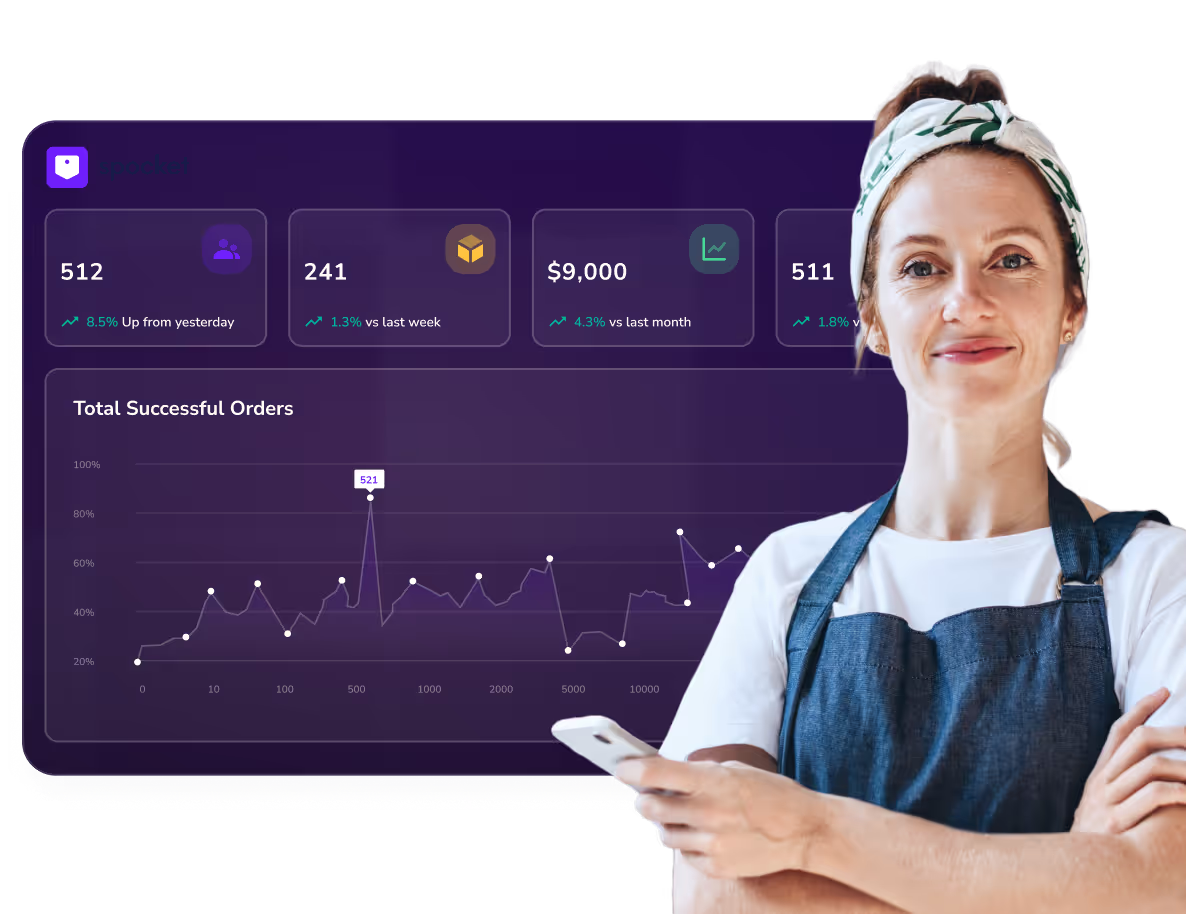In B2B, customer retention is just as important—if not more so—than acquiring new clients. While bringing in new customers is vital, keeping existing ones loyal can lead to long-term success and cost savings. The truth is, retaining a customer is cheaper and more rewarding than constantly seeking new ones.
So, how do you keep your B2B customers coming back? That’s where solid customer retention strategies come in. These are the tactics and approaches that help build strong, lasting relationships with clients, ensuring they stick around for the long run.
In this guide, we’ll dive into the most effective B2B retention strategies—whether you're a growing business or looking to improve your current practices. Get ready for actionable insights to help keep your clients happy and loyal.
What is B2B Customer Retention?

B2B customer retention refers to the strategies and efforts a business uses to keep its existing customers over the long term. Unlike B2C, where purchases are often one-time transactions, B2B relationships tend to be more complex and long-term. Retaining these customers is critical because repeat business is often more profitable than continually trying to acquire new customers.
In simple terms, customer retention focuses on making sure that once a business becomes your customer, they stay with you. It involves creating positive, ongoing relationships that lead to continued purchases, loyalty, and ultimately, customer advocacy.
Retention can be measured using key metrics like customer lifetime value (CLV), churn rate, and repeat purchase rate. These numbers help businesses gauge the success of their retention efforts and identify areas for improvement.
In B2B, customer retention isn’t just about keeping clients—it’s about turning them into long-term partners who rely on your products or services to grow their own businesses.
Key B2B Customer Retention Strategies
Customer retention in B2B is all about building relationships that last. It's not just about making a sale; it’s about ensuring that your clients stay with you over the long term. Here are some effective customer retention strategies to keep your customers coming back for more:
Personalized Customer Engagement
When it comes to retention, personalization is everything. Your customers don’t want to feel like just another number—they want to know you understand their needs. And with all the data available today, you can make that happen.
For example, use customer data to personalize emails, offer tailored product suggestions, or even create content that speaks directly to their business challenges. When customers feel like you’re speaking directly to them—and not just sending out generic messages—they’re much more likely to stay loyal to your brand.
Building Strong Relationships with Key Accounts
In B2B, some clients are just more important than others, and these key accounts deserve extra attention. Developing Account-Based Marketing (ABM) strategies can really help here. By focusing on a select group of high-value clients and creating personalized strategies for them, you can build deeper, more meaningful relationships. With the latest 2025 ABM trends, ABM tools are evolving to provide more personalized engagement at scale, making it easier to nurture relationships and deliver tailored solutions.
Regular check-ins, offering custom solutions, and even providing a dedicated account manager can go a long way in turning these clients into long-term partners. The more you understand their goals and help them achieve success, the harder it will be for them to leave.
Providing Exceptional Customer Support
Customer support shouldn’t just be about fixing problems—it’s about preventing them in the first place. Proactive support is key. Instead of waiting for a customer to come to you with an issue, reach out regularly to check in and ask how things are going. This shows you genuinely care about their success. For instance, many companies highlight in a recent Nextiva review how its unified communications tools helped them maintain consistent engagement with clients.
It also helps to create a self-service portal where clients can find answers to common questions, troubleshoot problems, or access tutorials. The more you empower your customers to solve things on their own, the better their experience will be.
Rewarding Loyalty
Who doesn’t love a little recognition? Offering rewards for loyalty is a great way to keep your B2B customers happy and engaged. This doesn’t have to be anything extravagant—simple perks like discounts on future orders, early access to new products, or exclusive content can make a huge difference.
Loyalty programs make your customers feel appreciated and valued, which strengthens the relationship and encourages them to stick around for the long haul.
Creating a Seamless Customer Experience
In today’s fast-paced world, convenience is key. If your customers find it difficult to place an order, get support, or access the information they need, they’ll quickly get frustrated—and look for alternatives.
By streamlining your processes and integrating your systems, you can create a seamless customer experience. This could be as simple as having a unified platform where sales, support, and marketing teams are all on the same page. When everything works smoothly, it makes your customers' lives easier—and they’ll reward you with their continued business.
Using Data & AI for Retention
The power of data and AI cannot be overstated. With the right tools, you can predict when a customer might be about to leave, and take action before it happens. By analyzing customer behavior, you can identify patterns that signal potential churn—and act on them.
AI can also help personalize customer interactions. From automated chatbots providing instant support to data-driven recommendations that increase sales, AI tools are a game-changer when it comes to improving the customer experience and boosting retention.
Implementing Customer Retention Tactics in Your B2B Strategy

Now that we’ve covered the top retention strategies, it’s time to talk about how to put them into action. Implementing these tactics successfully requires a bit more than just knowing what to do—it’s about creating a culture of retention across your organization and tracking your success every step of the way.
Developing a Retention-Focused Company Culture
For retention to really work, it needs to be part of your company’s DNA. It’s not just the job of the customer service team or the account managers—it’s something that should be embraced company-wide. Start by getting your team on the same page. Provide training and resources to help everyone understand the importance of retention and how they can contribute, whether they’re in sales, marketing, or support.
Encouraging a customer-first mindset can make a huge difference. When your team genuinely cares about your clients’ success, it becomes much easier to build long-lasting relationships.
Measuring Success: Key Metrics & KPIs
If you’re not tracking your progress, how will you know if your retention efforts are working? To truly understand the effectiveness of your strategies, it’s important to measure key metrics. Some of the most important retention KPIs include:
- Customer Lifetime Value (CLV): This metric helps you understand how much revenue a customer will generate over the course of their relationship with your business. The higher the CLV, the more successful your retention efforts are.
- Churn Rate: The churn rate tells you what percentage of customers are leaving. Reducing churn is often a clear indicator that your retention strategies are making an impact.
- Repeat Purchase Rate: This tracks how often customers come back to make additional purchases. A higher rate means that your clients are returning and staying loyal to your brand.
By regularly measuring these metrics, you can adjust your strategies as needed and keep improving your retention efforts.
Overcoming Common B2B Retention Challenges
Customer retention in B2B isn’t always smooth sailing. While the strategies we've discussed are effective, every business faces unique challenges. Whether it’s dealing with complex products, managing high customer expectations, or simply trying to stand out in a crowded market, it’s important to be prepared for the hurdles that can impact your retention efforts.
Let’s take a look at some common challenges in B2B customer retention and how you can overcome them.
1. Complex Products or Services
When your product or service is complex, it can be harder for customers to fully grasp its value. If customers don’t fully understand how your product benefits them, they may not stick around. The solution? Customer education.
Offering personalized training, onboarding sessions, and tutorials can help ensure your customers are getting the most out of your product. This is especially true for B2B companies offering software, machinery, or services that require technical expertise. By providing easy-to-access learning resources, webinars, or a dedicated customer success manager, you can help clients get up to speed and stay engaged.
2. Managing High Customer Expectations
B2B clients often have high expectations for the products or services they’re purchasing. When those expectations aren’t met, it can lead to dissatisfaction and churn. So, how do you manage those expectations and keep clients happy?
Clear communication is the key. Regular check-ins, clear timelines, and being upfront about what your product can and can’t do will help prevent any surprises. Additionally, providing ongoing support, being responsive, and offering proactive solutions to problems can make a big difference in keeping customers satisfied.
3. Lack of Personalization
Many B2B companies treat customers as a homogeneous group, using the same messaging and solutions for everyone. However, this approach can hurt retention in the long run. Every client is unique, and offering a one-size-fits-all approach can leave them feeling undervalued.
Investing in personalization is key to long-term retention. Leverage customer data to tailor communication, offers, and solutions to meet the specific needs of each client. It’s about making your clients feel valued and understood, which in turn strengthens their loyalty to your brand.
4. Disjointed Customer Experience
A disjointed experience across various touchpoints can create frustration and lead to churn. If a customer gets inconsistent experiences when interacting with different departments (sales, support, marketing), it can feel like they’re not getting the service they deserve.
To solve this, create a unified experience. Ensure your sales, customer support, and marketing teams are aligned and have access to the same customer data. This way, the customer feels like they’re receiving a seamless experience regardless of the department they interact with. Integrated systems, shared data, and consistent messaging can help bridge these gaps.
5. Inability to Measure Retention Effectively
Without the right metrics, it’s hard to know whether your retention efforts are working. Customer churn is a common challenge many businesses face, but if you’re not measuring it effectively, you might miss the signs of dissatisfaction until it’s too late.
Make sure you’re tracking the right KPIs like customer lifetime value (CLV), churn rate, and repeat purchase rate. These metrics will help you see where you're succeeding and where there's room for improvement. Regularly analyze customer feedback, conduct satisfaction surveys, and be proactive in addressing issues as they arise.
The Future of B2B Customer Retention
The landscape of B2B customer retention is constantly evolving. As technology advances and customer expectations shift, it’s essential to stay ahead of the curve to keep your clients loyal and engaged. Let’s explore some key trends that will shape the future of B2B customer retention and how you can prepare for them.
1. Increased Use of AI and Automation
One of the biggest trends we’re seeing in B2B customer retention is the growing role of AI and automation. AI tools are already being used to predict customer behavior, personalize experiences, and even automate customer service interactions.
For example, AI-driven chatbots are providing instant support, helping to resolve issues before they escalate. Automation tools are enabling personalized email campaigns and marketing efforts that nurture customer relationships without manual effort. In the future, we can expect AI to play an even bigger role in driving customer retention by automating more processes, improving personalization, and anticipating customer needs.
2. Hyper-Personalization
As customers become more accustomed to personalized experiences, the bar for B2B businesses is rising. Customers no longer expect just “good service” — they want experiences that are tailored to their specific needs. This means understanding your clients on a deeper level than ever before.
Using data analytics and AI, you’ll be able to hyper-personalize interactions—sending clients specific offers based on their past behaviors, addressing their individual pain points, and offering tailored solutions that speak directly to their business goals. Hyper-personalization will continue to be a crucial driver of retention in the future.
3. The Role of Customer Success Teams
Customer success teams have become central to B2B retention efforts. These teams are dedicated to ensuring that customers get the most value out of your product or service and are often the first line of defense when a client faces challenges.
As the importance of customer retention continues to grow, customer success will become even more integral to your strategy. These teams will focus on proactively engaging with clients, offering solutions before problems arise, and identifying opportunities for upselling and cross-selling. Their role will only become more critical as businesses focus on keeping customers happy long-term.
4. Data-Driven Retention Strategies
Data will continue to be a driving force behind retention efforts. With access to more customer data than ever before, B2B companies will be able to track customer behavior, predict churn, and offer personalized experiences based on insights.
The future of customer retention is deeply rooted in predictive analytics, allowing businesses to identify at-risk customers and take action before they churn. By continuously collecting and analyzing data, B2B companies can create more effective, targeted retention strategies that are tailored to the unique needs of their clients.
5. Seamless Omni-Channel Experiences
As customer expectations shift towards seamless experiences across all channels, B2B businesses must ensure they offer omni-channel support. Whether clients are engaging with your company via email, phone, chat, or social media, the experience should feel consistent and integrated.
In the future, customers will expect a seamless, cohesive experience regardless of how they interact with your business. Investing in integrated systems and ensuring all departments are aligned in delivering a consistent experience will be key to improving customer retention.
Conclusion
B2B customer retention is all about building strong, lasting relationships. It's not just about keeping customers around—it’s about making sure they get real value from your product or service and feel genuinely supported along the way. By personalizing experiences, providing exceptional customer support, and using data to understand their needs, you can build loyalty that lasts for years.
As the future of B2B evolves, embracing new trends like AI, hyper-personalization, and seamless customer experiences will be key to staying ahead of the competition. Keep your focus on your clients, and always look for ways to improve their experience. The more effort you put into retaining your customers, the more successful your business will be in the long run.






































